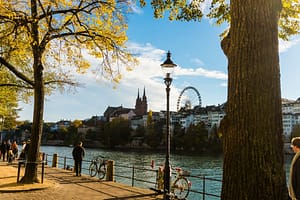Old Town
The part of Basel that lies roughly between the river and the old city gate at Spalentor is not large but quite atmospheric with its stone streets, medieval churches, beautifully maintained old homes, and brightly painted fountains. But leave it to Basel to introduce a thoroughly modern and whimsical fountain by Swiss sculptor Jean Tinguely in the midst of the stately historic houses. Filling a pool in Theaterplatz is a series of playful and ingenious water-spouting contraptions made of scrap metal. In winter, these freeze into fantastic ice sculptures.
From Marktplatz, wander west along Spalenberg with detours into some of the narrow side streets, such as Leonhardsberg and Spalenberg, Heuberg. This was the old artisans’ neighborhood. Or wander along Freiestrasse, which begins with the Renaissance Geltenzunfthaus, from 1578. At number 25 is the guild-house of the locksmiths dating from 1488 and decorated in Baroque style in 1733. Look for more wall paintings at the guild-house of the Hausgenossen at 34. In the little Fischmarkt, you’ll find a reproduction of a Gothic fountain whose original you can see in the historical museum. The two-hour Stories of Basel’s Old Town walking tour explores the oldest parts of the city with a knowledgeable guide who will explain local history and highlight points of interest, stopping at major sightseeing destinations like Basler Münster, Rathaus, and Tinguely Fountain. The tour focuses on the area’s rich history and varied architecture.
Basler Münster (Basel Minster)
Set atop the highest point on Münsterhügel (Minster Hill), Basel’s Minster is easily spotted by its prominent spires and brightly patterned roof tiles. The spacious Münsterplatz, formerly the site of a Roman fort, is an elegant 18th-century square. Built of red sandstone from the Vosges mountains of France between the ninth and 13th centuries, the minster was rebuilt in Gothic style after an earthquake in 1356. But some of the original church remains. The high altar and much of the furnishings were destroyed by Protestants in 1529, but the greatest treasures were hidden in the sacristy vaulting and survived; you can see some in the historical museum.
Be sure to see the St. Gallus doorway in the north transept, with its many 12th-century Romanesque stone carvings – one of the oldest figured doorways in German-speaking Europe. The tympanum above the doorway shows the Wise and Foolish Virgins, with Christ enthroned above flanked by Peter and Paul. A large rose window lies above the doorway. Inside, the lower part of the choir is Romanesque; notice especially the capitals carved with rich foliage and animals. The Romanesque capitals in the nave and ambulatory are also noteworthy. In front of the pulpit, under glass, is a piece of the Late Romanesque pavement from the 12th century. From inside the church, you can access the stairs to the top of the south tower. The crypt, which can be entered from beside the choir, contains the tombs of 10th- to 13th-century bishops and an excellent Romanesque frieze on the piers; ceiling frescoes depict scenes from the life of the Virgin and other New Testament themes. The beautiful 15th-century double cloister, entered from Rittergasse, contains monuments ranging over a period of five centuries.
Spalentor
Dating from 1370, the Spalentor is a fortified gate marking the end of the old town. The town gate, once part of the old town walls, has stood alone since their destruction in 1866. Look to the left of the gate to find an early 19th-century letterbox with the emblem of the Basel pigeon. The adjacent Peterskirche (St. Peter’s Church) was rebuilt in the 15th century, but the vaulting in the choir is from an earlier 14th-century building. There are frescoes in the Eberler chapel and the nave. Adjacent is the university, with a botanical garden that was founded in the 16th century, one of the oldest in the world.
Zoologischer Garten (Zoo)
Basel’s large zoo is affectionately known as the Zolli by locals. Founded in 1874 with 510 European animals, today the zoo is known more for exotic species. With predators, primates, mammals, reptiles, birds, and aquatic life, the population ranges from seahorses to elephants, the latter now enjoying a new elephant enclosure added in 2015 with wallowing pools, showers, and a savannah-like environment. The lion enclosure and monkey house are highlights, along with the penguins in the vivarium, which also houses fish and reptiles. The aviary houses both indigenous and exotic birds, as well as birds of prey. The zoo has been particularly successful in breeding rhinoceros and cheetahs.
Haus zum Kirschgarten
One of the finest of Basel’s patrician houses, the Haus zum Kirschgarten was built between 1775 and 1780 in the early Classical style. It was the home and office of a prosperous Basel manufacturer of silk ribbons and is among Switzerland’s best museums of domestic life. Throughout the 25 furnished rooms are displays of the furniture of a wealthy 18th-century commercial family as well as internationally important collections of decorative arts. The Pauls-Eisenbeiss Foundation’s collection of porcelain, a significant watch and clock collection, and major groups of Basel silver and scientific instruments are displayed.
Fondation Beyeler
The Fondation Beyeler was created by collectors Ernst and Hildy Beyeler, opened in 1997 to allow the public to enjoy their extensive personal collection of Classic Modernist art. Among the art on display are a staggering number of works by both Pablo Picasso and Henri Matisse, including drawings, paintings, and sculpture. There are also multiple sculptures by Alberto Giacometti and Max Ernst, and a variety of works by celebrated artists, including Georges Seurat, Marc Chagall, Marlene Dumas, Paul Klee, and Vincent Van Gogh. The collection also includes pieces from the Beyelers’ world travels to Africa, Oceania, and Alaska. The museum is set in a lovely park, housed in a building designed by architect Renzo Piano.

